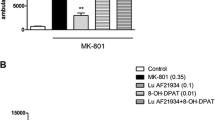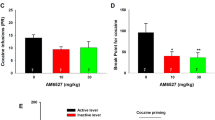Abstract
Rationale
Neurotensin-1 (NT1) receptor agonists have been proposed as putative antipsychotic drugs. Recently, brain-penetrating NT analogs produced by stability-enhancing modification of the smallest NT fragment, NT(8–13), have demonstrated antipsychotic-like efficacy after acute systemic injection in several preclinical animal tests predictive for antipsychotic efficacy. However, the evidence regarding the persistence versus tolerance of these effects after repeated administration is ambiguous. Previous studies have used compounds that nonselectively activated both NT1 and NT2 receptors or used continuous slow, central infusion of doses rather than daily acute administration, both factors which may have contributed to the ambiguity in the literature regarding the emergence of tolerance.
Objectives
To determine if tolerance develops to the antipsychotic-like effects of NT1 receptor agonists, we investigated the effects of subchronic daily systemic administration of PD149163, a brain-penetrating NT analog with selectivity for the NT1 receptor, on amphetamine-induced locomotor activation, a classic preclinical test of antipsychotic efficacy.
Materials and methods
Sprague–Dawley rats were pretreated with eight consecutive daily subcutaneous (SC) injections of PD149163 or saline. On the ninth day, rats received a pair of SC injections consisting of PD149163 or saline, followed by amphetamine (0.5 mg/kg) or saline. Locomotor activity was then measured in photobeam-equipped cages.
Results
The results indicated that repeated daily administration of PD149163 was able to antagonize amphetamine’s locomotor-activating effect comparable to that of the first dose, despite that repeated administration of PD149163 produced an increase in baseline locomotor activity not seen after the first dose.
Conclusions
The results do not support the development of tolerance for the acute antipsychotic-like effect of NT1 agonists and thus lend support to the contention that NT1 agonists are viable candidates as putative novel antipsychotic drugs.


Similar content being viewed by others
References
Andersen MP, Pouzet B (2001) Effects of acute versus chronic treatment with typical or atypical antipsychotics on d-amphetamine-induced sensorimotor gating deficits in rats. Psychopharmacology (Berl) 156:291–304
Boules M, Fredrickson P, Richelson E (2005) Neurotensin agonists as an alternative to antipsychotics. Expert Opin Investig Drugs 14:359–369
Boules M, Iversen I, Oliveros A, Shaw A, Williams K, Robinson J, Fredrickson P, Richelson E (2007) The neurotensin receptor agonist NT69L suppresses sucrose-reinforced operant behavior in the rat. Brain Res 1127:90–98
Boules M, McMahon B, Wang R, Warrington L, Stewart J, Yerbury S, Fauq A, McCormick D, Richelson E (2003) Selective tolerance to the hypothermic and anticataleptic effects of a neurotensin analog that crosses the blood-brain barrier. Brain Res 987:39–48
Boules M, Warrington L, Fauq A, McCormick D, Richelson E (2001) A novel neurotensin analog blocks cocaine- and d-amphetamine-induced hyperactivity. Eur J Pharmacol 426:73–76
Ervin GN, Nemeroff CB (1988) Interactions of neurotensin with dopamine-containing neurons in the central nervous system. Prog Neuro-psychopharmacol Biol Psychiatry 12(Suppl):S53–S69
Feifel D, Melendez G, Priebe K, Shilling PD (2007) The effects of chronic administration of established and putative antipsychotics on natural prepulse inhibition deficits in Brattleboro rats. Behav Brain Res 81:278–286
Feifel D, Melendez G, Shilling PD (2003a) PD149163, a neurotensin agonist, attenuates prepulse inhibition deficits produced by dizocilpine and DOI. Neuropsychopharmacology 28:651–653
Feifel D, Melendez G, Shilling PD (2003b) A systemically administered neurotensin agonist blocks disruption of prepulse inhibition produced by a serotonin-2A agonist. Neuropsychopharmacology 28:651–653
Feifel D, Melendez G, Shilling PD (2004) Reversal of sensorimotor gating deficits in Brattleboro rats by acute administration of clozapine and a neurotensin agonist, but not haloperidol: a potential predictive model for novel antipsychotic effects. Neuropsychopharmacology 29:731–738
Feifel D, Minor KL, Dulawa S, Swerdlow NR (1997) The effects of intra-accumbens neurotensin on sensorimotor gating. Brain Res 760:80–84
Feifel D, Reza TL, Wustrow DJ, Davis MD (1999) Novel antipsychotic-like effects on prepulse inhibition of startle produced by a neurotensin agonist. J Pharmacol Exp Ther 288:710–713
Fuxe K, Von Euler G, Agnati LF, Merlo Pich E, O’Connor WT, Tanganelli S, Li XM, Tinner B, Cintra A, Carani C et al (1992) Intramembrane interactions between neurotensin receptors and dopamine D2 receptors as a major mechanism for the neuroleptic-like action of neurotensin. Ann NY Acad Sci 668:186–204
Hadden MK, Orwig KS, Kokko KP, Mazella J, Dix TA (2005) Design, synthesis, and evaluation of the antipsychotic potential of orally bioavailable neurotensin (8–13) analogues containing non-natural arginine and lysine residues. Neuropharmacology 49(8):1149–1159
Hertel P, Byskov L, Didriksen M, Arnt J (2001) Induction of tolerance to the suppressant effect of the neurotensin analogue NT69L on amphetamine-induced hyperactivity. Eur J Pharmacol 422:77–81
Hertel P, Olsen CK, Arnt J (2002) Repeated administration of the neurotensin analogue NT69L induces tolerance to its suppressant effect on conditioned avoidance behaviour. Eur J Pharmacol 439:107–111
Kapur S, VanderSpek SC, Brownlee BA, Nobrega JN (2003) Antipsychotic dosing in preclinical models is often unrepresentative of the clinical condition: a suggested solution based on in vivo occupancy. J Pharmacol Exp Ther 305(2):625–631
Kinkead B, Binder EB, Nemeroff CB (1999) Does neurotensin mediate the effects of antipsychotic drugs? Biol Psychiatry 46:340–351
Kinkead B, Nemeroff CB (2004) Neurotensin, schizophrenia, and antipsychotic drug action. Int Rev Neurobiol 59:327–349
Norman C, Beckett S, Spicer, CH, Ashton D, Langlois X, Bennett GW (2008) Effects of chronic infusion of neurotensin and neurotensin NT1 selective analogue PD149163 on amphetamine-induced hyperlocomotion. J Psychopharmacol (in press). doi:10.1177/0269881107083838
Petrie KA, Bubser M, Casey CD, Davis MD, Roth BL, Deutch AY (2004) The neurotensin agonist PD149163 increases Fos expression in the prefrontal cortex of the rat. Neuropsychopharmacology 29:1878–1888
Samaha AN, Reckless GE, Seeman P, Diwan M, Nobrega JN, Kapur S (2008) Less is more: antipsychotic drug effects are greater with transient rather than continuous delivery. Biol Psychiatry (in press). doi:10.1016/j.biopsych.2008.01.010
Wang R, Boules M, Gollatz E, Williams K, Tiner W, Richelson E (2005) Effects of 5 daily injections of the neurotensin-mimetic NT69L on the expression of neurotensin receptors in rat brain. Brain Res Mol Brain Res 138:24–34
Wang R, Boules M, Tiner W, Richelson E (2004) Effects of repeated injections of the neurotensin analog NT69L on dopamine release and uptake in rat striatum in vitro. Brain Res 1025:21–28
Wustrow DJ, Davis MD, Akunne HC, Corbin AE, Wiley JN, Wise LD, Heffner TG (1995) Reduced amide bond neurotensin 8–13 mimetics with potent in vivo activity. Bioorg Med Chem Lett 5:997–1002
Acknowledgements
We thank Joseph R. Goldenberg, Phyllis Huang, David Goldenberg, and James M. Clinton for their excellent technical assistance. DF and PDS are partially funded by NIMH grant MH62451.
Author information
Authors and Affiliations
Corresponding author
Rights and permissions
About this article
Cite this article
Feifel, D., Melendez, G., Murray, R.J. et al. The reversal of amphetamine-induced locomotor activation by a selective neurotensin-1 receptor agonist does not exhibit tolerance. Psychopharmacology 200, 197–203 (2008). https://doi.org/10.1007/s00213-008-1197-5
Received:
Accepted:
Published:
Issue Date:
DOI: https://doi.org/10.1007/s00213-008-1197-5




